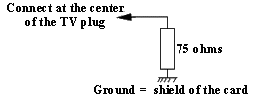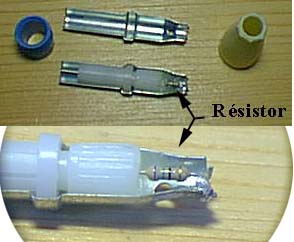Preamble |
The Meteor software functions correctly only if your radio
installation is stable and can detect meteor echoes effectively. Concerning
the materials necessary see the technical pages.
Dave Swan (U.K)
created a protocol to the test the stability of your radio installation.
I strongly recommend you read it to assure that only a received signal from
an echo is counted. |
||||
| To install, Unzip MV6.ZIP in a temporary directory then run SETUP.EXE, it will display this screen in French and English. |
|
||||
| After the automatic installation on your Hard Disk Meteor v 6.0 is complete, it will run automatically. Here is the first screen: Choose your language? |
|
||||
| Next choose the PC’s Com Port (ex. COM1) where your Meteor Electronic Interface Box (MEIB) is connected. |
|
||||
| Now, Meteor will adjust the sampling. The time it will take depends on the computer speed and the strength of the low-frequency signal from the output of your receiver. At the end, the colour of the trace changes from red to green and Meteor evaluate the Window’s time scan. |
|
||||
| Meteor should now be running properly. Please adjust the thresholds and the delay as needed. Don't forget to select the back-up delay also. Here, 30 MN (minutes) is selected. |
|
||||
| Here a classic "echo peak" is detected by crossing the high threshold. The colour changes from green to red and returns to green after the delay if the value is inside the thresholds. At the bottom of the screen the day count of the meteors appear as 3D bars. |
|
||||
| If 2 echoes occur during the time delay Meteor counts only 1 echo and the delay restarts from the last crossing of the threshold. This process exist to stop excessive counts occurring from the passage of aeroplanes or periods of sporadic E. |
|
||||
| Meteor generates different types of files. Here’s a brief description. | The STA files
(Statistic) A file of this type is created automatically every day. Its
name indicates the date (MMDDYYYY.STA), ex: 12082002.STA = 12 August 2002.
It is a simple DOS text file readable with Notepad, etc. The first column
indicates the hour in universal time (UT), the semi-colon serves as the separator
for the following column, which indicates the number of echoes counted in
hourly ex: 0;25 = 25 echoes between 0h and 0h59mn59s.
The STA files are fundamental data, so it is prudent to save them in case of a system reset. They also allow Meteor v 6.0 to create the monthly report for your observations for the RMOB (Radio Meteor Observing Bulletin). This bulletin is a text file that will permit you to distribute and to compare your observations with the other observers around the world via the Internet. See http://www.rmob.org Meteor creates this RMOB file automatically. The name of this file corresponds to the month e.g : RMOB012002.TXT = RMOB of January 2002. Its organization is simple and easy to understand, if you look at it with a text editor such as Microsoft's WordPad or Notepad. You can use this file to visualize your data as a graphic image with Colorgramme On Line on http://www.rmob.org The File RAW (Files of data) If you check the RAW files in Meteor, you see it creates a file. Its name indicates the date and the hour, created automatically each hour, ex.: 18110206.RAW = 18 November 2002 slice 06 h UT. These files are encoded with 8 bits and are readable for analysis using Colorgramme v 2.2. See analysis page. Attention: the RAW file stores and measures all that appears on screen and creates a 16 Kb. (Kilobytes) file each hour that may quickly fill up your PC’s hard drive. The File DUR(enDURe).This text file is created automatically if you check the desired selection for the duration [DUR]; the information concerning the length of echoes is then saved. Meteor creates one file per hour, which carries the name of the day and the hour the same as the RAW files. A column indicates the number of the echo, the separator is a vertical bar ‘|’. Then one finds the hour of the beginning of the echo (detection), then the valued length in pixel number on screen, followed by a -> this indicates the estimated duration in time. The last column indicates the duration time out of the thresholds in pixels number and -> time. Note: The [DUR] file is in the experimental stage, under development, and will be upgraded in future versions of Meteor. |
||||
|
|
|||||
Meteor Ver. 6 System Set-up by Dave Swan (UK) |
|

How to build? Take a 50/75 ohm plug and solder one end of a 50/75 ohm resistor to the centre pin and the other end to the outer case. |
1. Connect up
the system and set the receiver to the frequency in use.
Terminate the receiver antenna input in its Characteristic Impedance, this is usually 50 ohm for professional or scanning receivers and 75ohms for Band 2 FM stereo receivers. Use only carbon resistors not wire wound. Reset the system and adjust the Threshold controls above and below the displayed Noise level so that the system is not triggered into producing a count. If the system is triggered adjust the necessary threshold to prevent this. When the system is running with no triggering observe for at least 30 minutes to confirm no random triggering of the system. If random triggering persists the probable cause is man-made noise getting through the power lines or computer hash usually the monitor, fit an appropriate filter. If an RF Signal Generator is available, see Annex A. Continuing from 3. Observe the displayed noise level and remove the terminating resistor and refit the antenna, if the antenna is a good match and there is no man-made noise present, you should see no major increase in noise. Reset the system, and you are ready to start observing. Changing any of the system components will require system Reset. This set-up is to ensure that the system itself is not generating false counts! Annex A: At this point the system sensitivity can be measured. If any problems occur with this procedure contact: daveswan@dorsetpubs.com |
|
|
| Meteor v 6.0 is the result of collective work <?> button display the contributors, without stop the measures. |
|
Any question available on meteor@ml.free.fr the list of Meteor program. To subscribe please click on the button below and after You receive 2 mails from LISTAR please REPLY " Subscription confirmation for 'meteor' " to confirm your subscription. |
|









